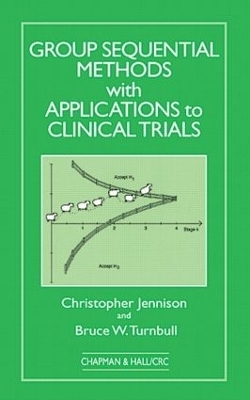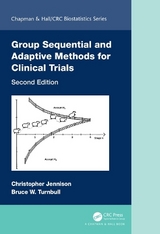
Group Sequential Methods with Applications to Clinical Trials
Seiten
1999
Crc Press Inc (Verlag)
978-0-8493-0316-6 (ISBN)
Crc Press Inc (Verlag)
978-0-8493-0316-6 (ISBN)
Zu diesem Artikel existiert eine Nachauflage
Describes group sequential stopping rules designed to reduce average study length and control Type I and Type II error probabilities. This book presents one-sided and two-sided tests, introduces several families of group sequential tests, and explains how to choose the most appropriate test and interim analysis schedule.
Group sequential methods answer the needs of clinical trial monitoring committees who must assess the data available at an interim analysis. These interim results may provide grounds for terminating the study-effectively reducing costs-or may benefit the general patient population by allowing early dissemination of its findings. Group sequential methods provide a means to balance the ethical and financial advantages of stopping a study early against the risk of an incorrect conclusion.
Group Sequential Methods with Applications to Clinical Trials describes group sequential stopping rules designed to reduce average study length and control Type I and II error probabilities. The authors present one-sided and two-sided tests, introduce several families of group sequential tests, and explain how to choose the most appropriate test and interim analysis schedule. Their topics include placebo-controlled randomized trials, bio-equivalence testing, crossover and longitudinal studies, and linear and generalized linear models.
Research in group sequential analysis has progressed rapidly over the past 20 years. Group Sequential Methods with Applications to Clinical Trials surveys and extends current methods for planning and conducting interim analyses. It provides straightforward descriptions of group sequential hypothesis tests in a form suited for direct application to a wide variety of clinical trials. Medical statisticians engaged in any investigations planned with interim analyses will find this book a useful and important tool.
Group sequential methods answer the needs of clinical trial monitoring committees who must assess the data available at an interim analysis. These interim results may provide grounds for terminating the study-effectively reducing costs-or may benefit the general patient population by allowing early dissemination of its findings. Group sequential methods provide a means to balance the ethical and financial advantages of stopping a study early against the risk of an incorrect conclusion.
Group Sequential Methods with Applications to Clinical Trials describes group sequential stopping rules designed to reduce average study length and control Type I and II error probabilities. The authors present one-sided and two-sided tests, introduce several families of group sequential tests, and explain how to choose the most appropriate test and interim analysis schedule. Their topics include placebo-controlled randomized trials, bio-equivalence testing, crossover and longitudinal studies, and linear and generalized linear models.
Research in group sequential analysis has progressed rapidly over the past 20 years. Group Sequential Methods with Applications to Clinical Trials surveys and extends current methods for planning and conducting interim analyses. It provides straightforward descriptions of group sequential hypothesis tests in a form suited for direct application to a wide variety of clinical trials. Medical statisticians engaged in any investigations planned with interim analyses will find this book a useful and important tool.
Christopher Jennison, Bruce W. Turnbull
Glossary. Introduction. Two-Sided Tests: Introduction. Two-Sided Tests: General Applications. One-Sided Tests. Two-Sided Tests with Early Stopping Under the Null Hypothesis. Equivalence Tests. Flexible Monitoring: The Error Spending Approach. Analysis Following a Sequential Test. Repeated Confidence Intervals. Stochastic Curtailment. General Group Sequential Distribution Theory. Binary Data. Survival Data. Internal Pilots Studies: Sample Size Re-Estimation. Multiple Endpoints. Multi-Armed Trials. Adaptive Treatment Assignment. Bayesian Approaches. Numerical Computations for Group Sequential Tests. References
NTI/Sales Copy
| Erscheint lt. Verlag | 15.9.1999 |
|---|---|
| Reihe/Serie | Chapman & Hall/CRC Biostatistics Series |
| Zusatzinfo | 69 Tables, black and white |
| Verlagsort | Bosa Roca |
| Sprache | englisch |
| Maße | 156 x 234 mm |
| Gewicht | 880 g |
| Themenwelt | Mathematik / Informatik ► Mathematik ► Angewandte Mathematik |
| Medizin / Pharmazie ► Medizinische Fachgebiete ► Laboratoriumsmedizin | |
| ISBN-10 | 0-8493-0316-8 / 0849303168 |
| ISBN-13 | 978-0-8493-0316-6 / 9780849303166 |
| Zustand | Neuware |
| Informationen gemäß Produktsicherheitsverordnung (GPSR) | |
| Haben Sie eine Frage zum Produkt? |
Mehr entdecken
aus dem Bereich
aus dem Bereich
Schulbuch Klassen 7/8 (G9)
Buch | Hardcover (2015)
Klett (Verlag)
CHF 29,90



